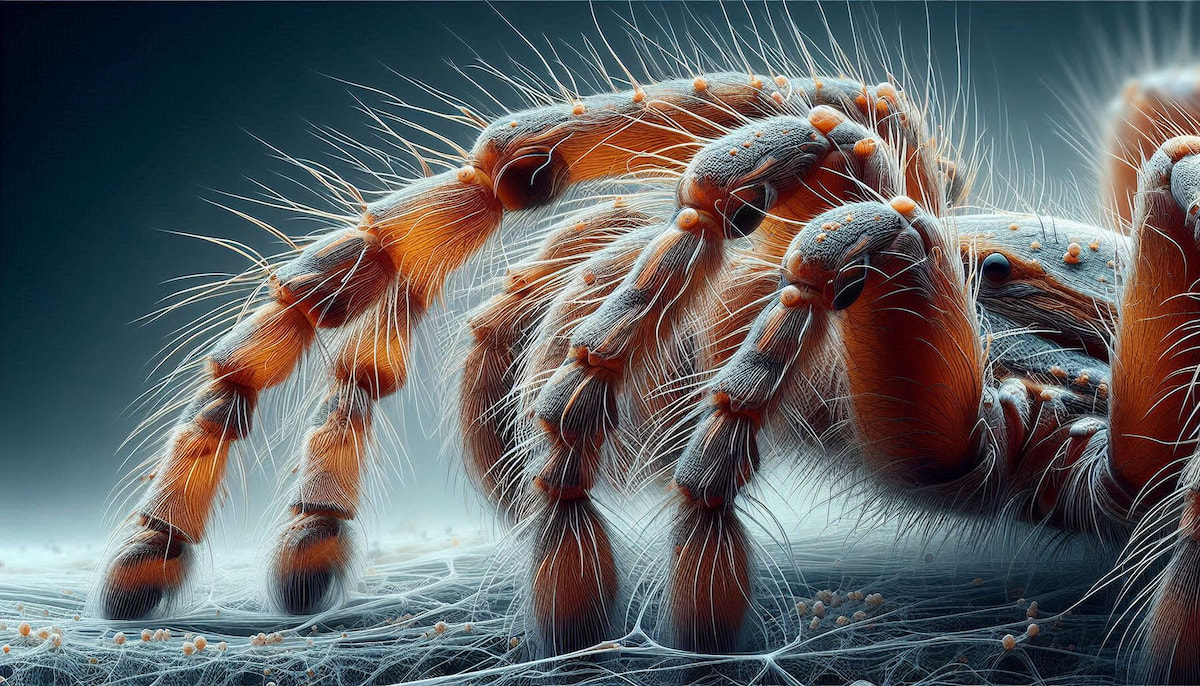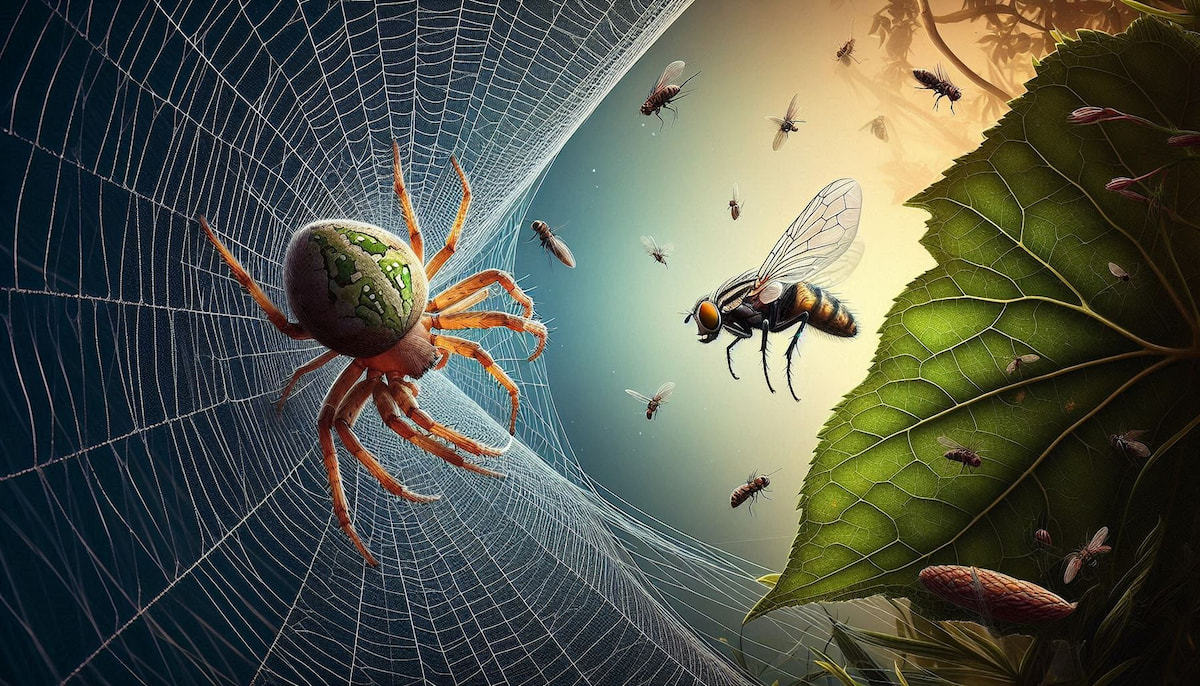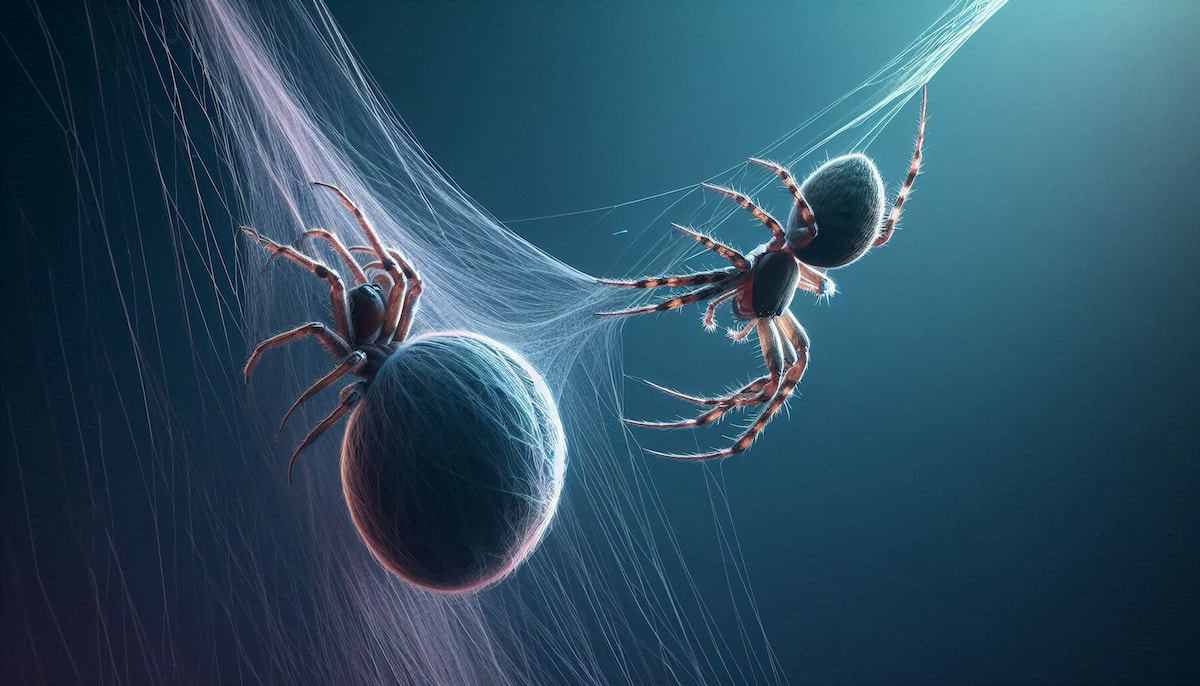
Watch short for this article (5 slides)
A Spider's Sixth Sense... and Seventh, and Eighth: Exploring Their Remarkable Sensory World
Spiders inhabit nearly every corner of the globe, masters of stealth, architecture, and predation. Their success hinges on a suite of sophisticated sensory adaptations that allow them to perceive their environment in ways vastly different from our own. While recent fascinating research highlighted how male wasp spiders essentially "taste" female pheromones through sensory organs on their legs, this is just one thread in the complex web of spider senses. Lacking human-like ears and noses, spiders rely on exquisitely sensitive hairs, specialized cuticular organs, and unique eyes to navigate, hunt, and communicate. Let's delve into the science behind how spiders experience the world, focusing on the intricate mechanisms underpinning their hunting prowess and complex mating rituals.

Spiders utilize a complex array of senses to interact with their environment.
Beyond Human Senses: An Overview of Spider Perception
Spiders have evolved diverse ways to gather information, often prioritizing senses other than vision, depending on their lifestyle:
- Mechanoreception (Touch & Vibration): Arguably the most crucial sense for many spiders. Specialized hairs and organs detect minute vibrations in silk, the ground, water surfaces, or air currents, as well as direct physical contact.
- Vision: Highly variable across species. Some, like jumping spiders, possess exceptional, near-mammalian visual acuity, while many web-builders have relatively poor eyesight, relying more on other cues.
- Chemoreception (Taste & Smell): Detecting chemical signals, particularly pheromones for mating or assessing prey suitability, often occurs through specialized organs on their legs and pedipalps (mouthparts).
Feeling the World: Mechanoreception in Detail
Spiders live in a world defined by vibrations and tactile cues, detected through several key structures:
- Slit Sensilla & Lyriform Organs: These are perhaps the most unique spider sensory organs. Slit sensilla are tiny slits or cracks in the spider's exoskeleton, covered by a thin membrane. They function like strain gauges, detecting minute stresses and deformations in the cuticle caused by substrate vibrations (e.g., an insect walking nearby, struggling prey in a web) or potentially even low-frequency sound. Groups of parallel slits form complex lyriform organs, often located near leg joints, providing highly sensitive vibration detection across a range of frequencies. (Source: Oxford Scholarship Online - Spider Biology Chapter Extract - Context on sensilla)
- Trichobothria: These are exceptionally fine, long hairs set in socket-like bases, primarily located on the legs. They are incredibly sensitive to the slightest air currents and low-frequency airborne vibrations (sound). Trichobothria allow spiders to detect the presence and direction of flying insects, approaching predators, or even subtle air movements caused by larger animals nearby, acting like a form of "hearing" for air displacement.
- Tactile Setae: Numerous coarser hairs (setae) covering the body and legs respond to direct physical contact, providing information about texture, shape, and movement during interaction with prey, mates, or the environment.
A Spectrum of Sight: Spider Vision
Most spiders have eight eyes (though some have fewer), typically arranged in two rows. These eyes are generally divided into two types with different functions:
- Principal Eyes (AME - Anterior Median Eyes): Usually the large, forward-facing pair. Unique among arthropods, spiders can move the retinas of their principal eyes using tiny muscles, allowing them to scan their surroundings without moving their body. In some species, particularly jumping spiders, these eyes provide high-resolution, sharp, and even color vision.
- Secondary Eyes (ALE, PME, PLE): The remaining eyes often have a wider field of view and are highly sensitive to motion and low light levels. Many possess a tapetum lucidum, a reflective layer behind the retina that enhances vision in dim conditions (causing eyeshine when illuminated at night, noticeable in wolf spiders).
- Jumping Spider Super-Vision: Jumping spiders (Salticidae) are renowned visual predators. Their large AME provide exceptional spatial acuity, possibly exceeding that of some vertebrates relative to their size. They possess sophisticated depth perception (using retinal image defocus) and complex color vision (some species are trichromatic or even tetrachromatic, perceiving colors beyond human range). This visual prowess is crucial for stalking prey and engaging in intricate courtship displays. (Source: National Geographic - Spider Vision Overview)
- Other Visual Hunters: Wolf spiders use their sensitive secondary eyes for detecting motion at night, while net-casting spiders (Deinopidae) have enormous night-adapted eyes for spotting prey below their thrown nets. Conversely, many web-building spiders have poor vision, relying mainly on vibrations.

Jumping spiders possess large principal eyes that grant them exceptional vision for hunting and courtship.
Tasting and Smelling with Legs: Chemoreception
Spiders perceive chemical cues using specialized sensory organs, often concentrated on their legs and pedipalps:
- Chemosensitive Hairs and Pits: Hollow hairs and small pits (like the tarsal organs on the tips of their legs) contain dendrites of chemosensory neurons. These detect chemicals upon direct contact (contact chemoreception or "taste") or volatile chemicals carried in the air (olfaction or "smell").
- Pheromone Detection: As demonstrated in the wasp spider (*Argiope bruennichi*), male spiders use these leg organs to detect non-volatile female sex pheromones deposited on silk draglines. By "tasting" the silk, males can identify receptive females of their own species, assess their mating status, and potentially avoid rival males. (Source: University of Greifswald Research Summary)
- Other Functions: Chemoreception likely also plays roles in prey assessment (distinguishing palatable from unpalatable insects), habitat selection, and potentially kin recognition or aggregation behavior in social species.
Sensory Strategies for Survival: Hunting Techniques
Different spider groups have evolved hunting strategies heavily reliant on specific sensory modalities:
- Web-Building Spiders (e.g., Orb-weavers, Cobweb Spiders): Primarily rely on mechanoreception. They sit on or near their web, monitoring vibrations transmitted through the silk threads using their slit sensilla and leg hairs. They can often distinguish between trapped prey, potential mates plucking the web, rivals, environmental noise (wind, rain), and even the type/size of prey based on vibration frequency and amplitude. Vision is often poor; touch and chemoreception become important once prey is subdued.
- Active Hunters (e.g., Jumping Spiders, Wolf Spiders):
- Jumping Spiders: Primarily use their exceptional vision to detect, stalk, and accurately pounce on prey, judging distance precisely.
- Wolf Spiders: Employ a combination of vision (especially motion detection in low light via their large secondary eyes) and mechanoreception (detecting ground vibrations from moving insects) for nocturnal or crepuscular hunting.
- Ambush Hunters (e.g., Trapdoor Spiders, Crab Spiders):
- Trapdoor Spiders: Rely heavily on mechanoreception. They construct silk-lined burrows with camouflaged lids and often lay down silk "trip lines" radiating outwards. Vibrations transmitted through these lines signal passing prey, triggering a rapid ambush strike.
- Crab Spiders: Often camouflage themselves on flowers, relying on vision and potentially chemoreception to detect approaching pollinators, which they ambush with outstretched legs.
The Delicate Dance: Sensory Communication in Mating
Spider courtship is a high-stakes affair, particularly for males who risk being mistaken for prey by the often larger females (sexual cannibalism is common). Sensory communication is crucial for species recognition, signaling intent, and assessing mate quality.

Peacock spiders use vibrant colors and complex dances in their visual courtship rituals.
- Pheromonal Communication: Males follow airborne or substrate-bound (silk) pheromones released by females, using chemoreceptors on their legs and pedipalps to locate potential mates.
- Vibrational Courtship: A widespread strategy, especially among web-builders. Males approach the female's web and perform species-specific sequences of plucking, tapping, bouncing, or drumming on the silk threads. These vibrations signal the male's identity, species, and intent, allowing the female to recognize him as a potential mate rather than prey or a threat. The pattern and intensity may also convey information about the male's quality.
- Visual Displays: Predominant in spiders with good eyesight, like jumping spiders. Male peacock spiders (*Maratus* species) are famous for their incredibly complex courtship rituals involving raising and vibrating colorful abdominal flaps and legs in intricate "dances." Wolf spiders may use leg-waving signals. These visual cues likely convey species identity and male fitness.
- Tactile Communication: Upon close approach, gentle touching with legs or pedipalps can be part of the final stages of courtship before mating occurs.
Females assess these multi-modal signals to decide whether to accept a male for mating.
Comparative Sensory Worlds
| Spider Type | Primary Hunting Method | Key Sensory Adaptations | Primary Mating Signals |
|---|---|---|---|
| Orb-Weaving Spider | Web-based trapping | Mechanoreception (web vibrations via slit sensilla, trichobothria); poor vision. | Pheromones on silk; complex vibrational courtship (web plucking/drumming). |
| Jumping Spider | Active stalking & pouncing | Exceptional high-resolution, color vision; depth perception. | Complex visual displays (dances, color patterns); some vibrational components. |
| Wolf Spider | Active ground hunting (often nocturnal) | Good motion-detecting vision (especially low-light); substrate vibration detection. | Pheromone trails; visual signals (leg waving); possibly substrate vibrations. |
| Trapdoor Spider | Burrow ambush | Mechanoreception (substrate vibrations via silk trip lines); tactile cues. | Often minimal courtship; possibly pheromones or simple tactile signals near burrow. |
Conclusion: A World Perceived Differently
Spiders offer a compelling window into the diversity of sensory evolution. Lacking familiar human senses, they have developed extraordinary ways to "feel" vibrations through solid ground and silk threads, "hear" air currents with delicate hairs, "taste" chemical trails with their feet, and, in some cases, see the world with remarkable clarity and color. These adaptations are intricately linked to their specific lifestyles, enabling them to hunt effectively, avoid predators, and navigate the complex challenges of finding and wooing a mate – often while avoiding becoming a meal themselves. Ongoing research continues to reveal the sophistication of their sensory systems, reminding us that the world is perceived in far more ways than our own senses allow.